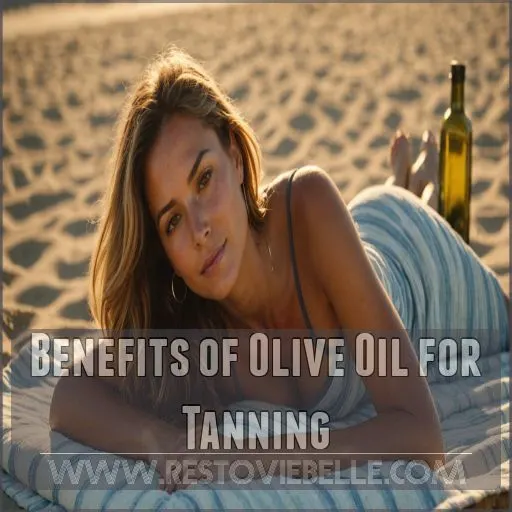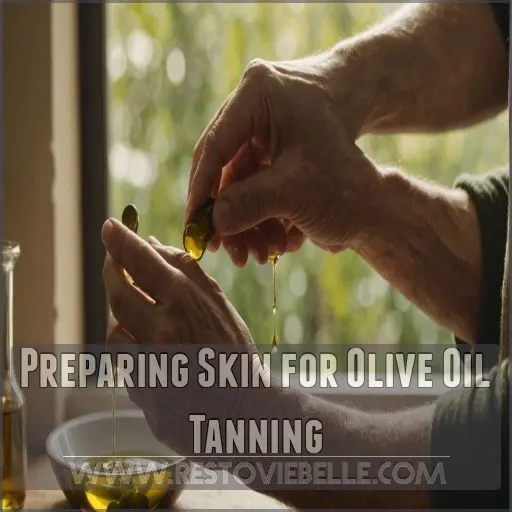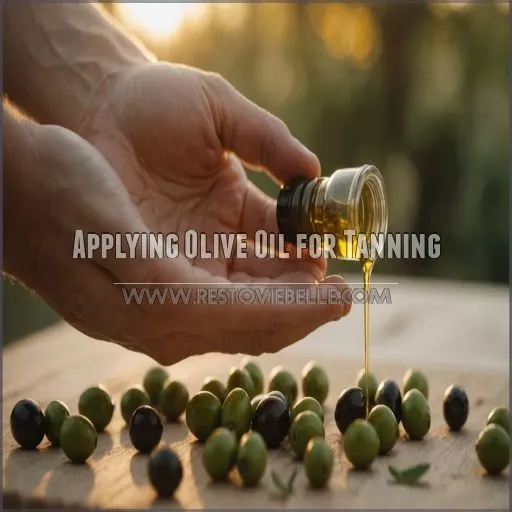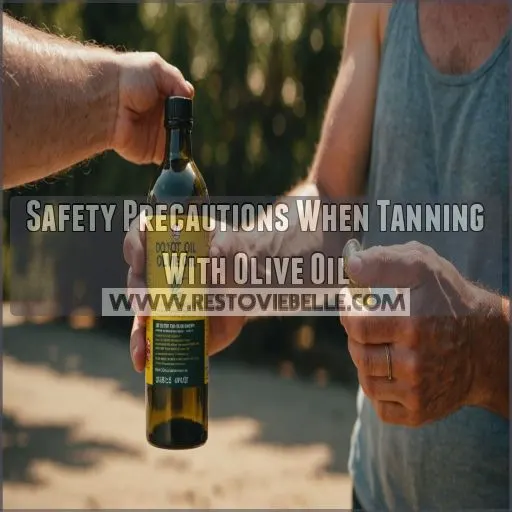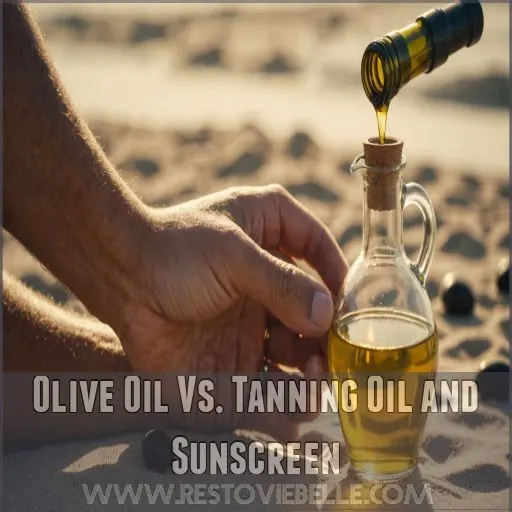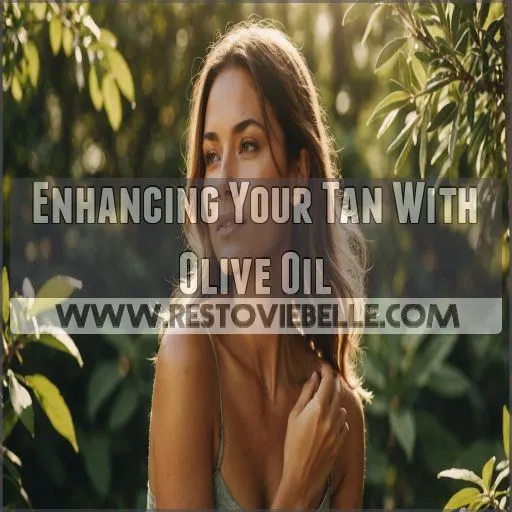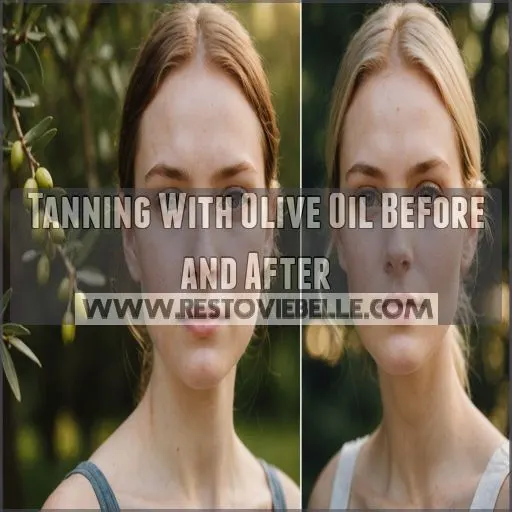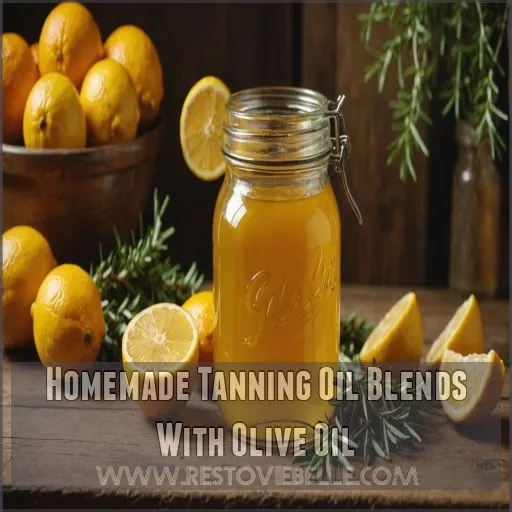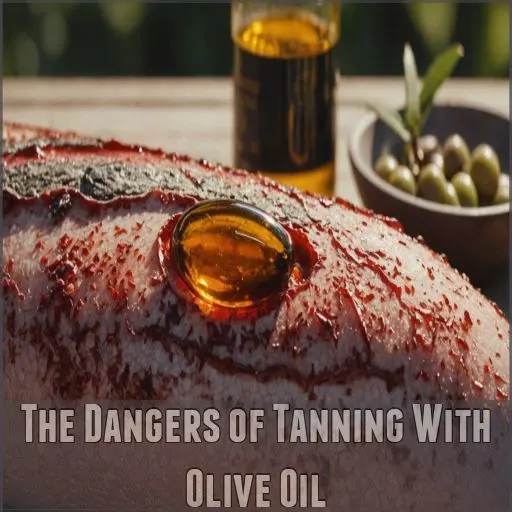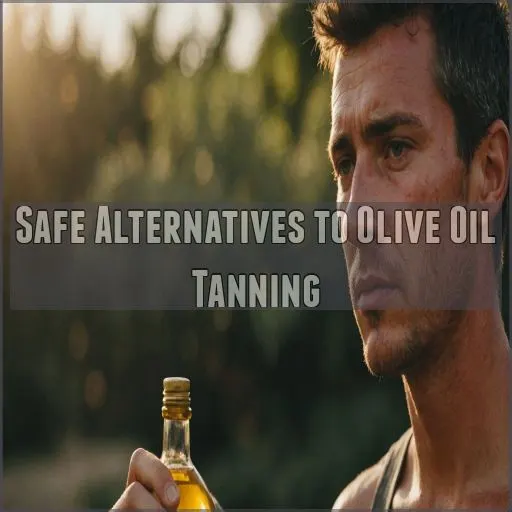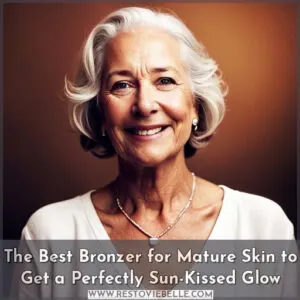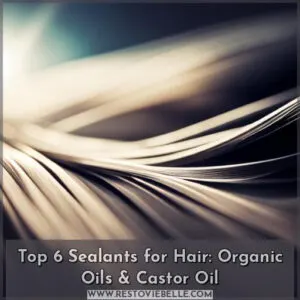This site is supported by our readers. We may earn a commission, at no cost to you, if you purchase through links.
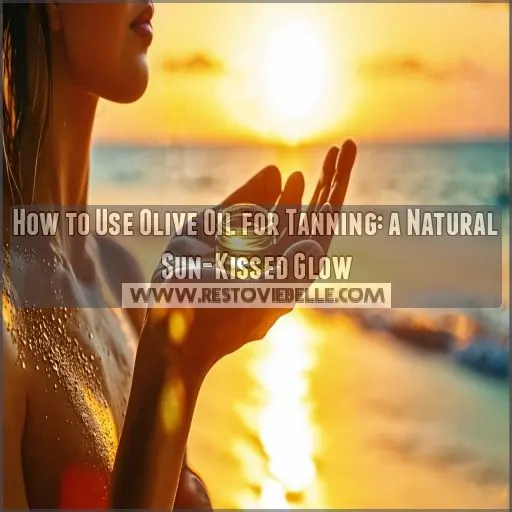
But don’t ditch the sunscreen! Olive oil offers limited UV protection, so you’ll still need that SPF. Limit sun exposure and take shade breaks every 30 minutes.
After tanning, hydrate your skin with aloe vera. Remember, while olive oil can nourish your skin, it’s not a magic shield against sun damage.
Curious about creating your own tanning blend? There’s more to explore in natural tanning oils.
Table Of Contents
- Key Takeaways
- Benefits of Olive Oil for Tanning
- Preparing Skin for Olive Oil Tanning
- Applying Olive Oil for Tanning
- Safety Precautions When Tanning With Olive Oil
- Olive Oil Vs. Tanning Oil and Sunscreen
- Enhancing Your Tan With Olive Oil
- Tanning With Olive Oil Before and After
- Homemade Tanning Oil Blends With Olive Oil
- The Dangers of Tanning With Olive Oil
- Safe Alternatives to Olive Oil Tanning
- Frequently Asked Questions (FAQs)
- Can You tan with olive oil?
- What is the best way to take olive oil?
- How do you use olive oil tanning lotion?
- Which olive oil is best for tanning?
- Does olive oil make you tan faster?
- Is it safe to put olive oil on your skin to tan?
- Should you put olive oil on before or after the sun?
- What oil makes you tan the fastest?
- Can olive oil help reduce tanning time?
- Does olive oil work for indoor tanning beds?
- How long does an olive oil tan last?
- Can olive oil remove existing tan lines?
- Is extra virgin olive oil better for tanning?
- Conclusion
Key Takeaways
- You’re not invincible with olive oil. While it can give you a sun-kissed glow, don’t ditch the sunscreen. Think of olive oil as your skin’s sidekick, not its superhero cape against UV rays.
- Mix it up for maximum benefits. Blend olive oil with coconut or almond oil, similar to using the best olive oil brands, for a custom tanning cocktail that’ll make your skin sing
. Just remember, even the fanciest DIY blend isn’t a substitute for proper sun protection.
- Timing is everything. Apply your olive oil before soaking up the sun, but give it a few minutes to absorb. It’s like prepping your skin for a first date with the sun – you want to make a good impression.
- After-sun care is crucial. Keep that olive oil handy for post-tanning TLC. It’s like giving your skin a cool drink after a hot day, helping to lock in moisture and potentially extending your tan’s lifespan.
Benefits of Olive Oil for Tanning
You might think the secret to a perfect tan lies in a bottle, but your kitchen may hold the answer.
Using olive oil can give you a sun-kissed glow while hydrating your skin and reducing inflammation.
Just don’t forget to lather on some sunscreen too!
Rich in Antioxidants and Healthy Fats
A bit of olive oil is like a superhero for your skin when you’re tanning. Its antioxidant power, combined with healthy fats, fights off those pesky free radicals and keeps your skin smooth.
Here are four benefits:
- Nourishing properties boost skin health.
- Antioxidants protect against damage.
- Natural hydration for softer skin.
- Healthy fats support elasticity.
Enjoy responsibly!
Hydrates and Softens the Skin
Although getting that sun-kissed glow is on your mind, olive oil’s ability to hydrate and soften your skin means it’s not all about the tan. The emollient properties help lock in moisture, important for dry skin remedies.
Here’s a quick tip chart:
| Benefit | Result |
|---|---|
| Moisturizes | Soft skin |
| Locks in moisture | Hydration boost |
| Easy application | Smooth texture |
| Natural ingredients | Skin-friendly |
| Affordable | Cost-effective |
Enjoy a softer you!
Anti-Inflammatory Properties
Using olive oil for tanning brings a secret weapon—its anti-inflammatory properties.
This natural elixir helps soothe skin inflammation and reduce redness, acting like a calm summer breeze on a hot day.
Ever compared olive oil vs. creams? Olive oil’s anti-inflammatory ingredients often win, easing skin irritation while offering skin care benefits for a healthier glow.
Protects Skin From UV Radiation
Surprisingly, olive oil offers some natural sun protection, akin to wearing a sun hat in a drizzle.
It blocks about 20% of UV rays, thanks to its rich squalene content.
Though it’s no substitute for your favorite sunscreen, it adds an extra layer in the fight against UV radiation.
Always pair olive oil with broad-spectrum SPF for skin protection.
Promotes Skin Regeneration
Harness the regenerative power of olive oil! Its vitamin E and antioxidants stimulate skin cell renewal, boosting collagen production for a healthy, youthful glow.
Massage this natural elixir into your skin before sun exposure to ward off free radical damage and keep your complexion looking radiant.
Embrace the anti-aging benefits of olive oil tanning by harnessing its antioxidant and vitamin-rich properties
!
Preparing Skin for Olive Oil Tanning
Before you let olive oil work its magic for that sun-kissed look, you’ve got to prep your skin to guarantee an even tan.
Think of it like painting a wall; you wouldn’t skip the primer, so don’t skip exfoliating away dead skin cells for a smooth, glowing finish.
Exfoliating Skin Before Tanning
Before tanning with olive oil, turn your skin into a smooth canvas with a bit of strategic exfoliating.
Think of it as pre-tan prep, giving you control over that sun-kissed glow.
Use the best exfoliating scrubs or try DIY exfoliation tips.
Just don’t overdo it.
Weekly exfoliation keeps things smooth, preventing any patchy mishaps while you’re basking in the sun.
Removing Dead Skin Cells
You’re ready to tan with olive oil, but first, focus on removing dead skin cells.
Think of it as tidying up before hosting a party.
Try exfoliation methods like using body brushing or DIY scrubs to enhance skin hydration.
Even microdermabrasion can help polish your skin tone.
This way, your natural sun-kissed glow shines without pesky skin pigmentation issues.
Ensuring an Even Tan
Now, with dead skin cells out of the way, achieve an even tan using these tips.
Focus on your exfoliating routine, ensuring each skin type gets care.
Before heading into sun exposure, remember these tanning tips:
- Apply olive oil generously.
- Avoid peak sun hours.
- Use DIY tanner recipes.
- Maintain skin moisture.
- Protect your skin barrier.
Applying Olive Oil for Tanning
Ready to harness olive oil for your tanning?
Start by massaging extra virgin olive oil onto your skin and give it a few minutes to soak in.
Before catching some rays—just don’t forget the sunscreen!
Using Extra Virgin Olive Oil
Selecting extra virgin olive oil guarantees high-quality tanning oil for your natural beauty routine.
After prepping your skin, apply a thin layer. Its rich antioxidants and moisture-locking properties are ideal for tanning at home.
Remember, proper oil storage maintains its effectiveness. Create DIY tanning blends by considering your skin type for optimized results.
Massaging Oil Into the Skin
First, gently massage the olive oil into your skin using circular motions.
Focus on areas prone to dryness, like elbows and knees, to lock in moisture and create an even, natural-looking tan.
The oil’s lustre will attract the sun’s rays, helping you achieve a gorgeous, sun-ked glow .
Allowing Oil to Absorb Before Sun Exposure
Waiting for olive oil to soak into your skin before sunbathing isn’t just a wise idea; it’s a tanning game-changer. As olive oil is rich in antioxidants and healthy fats, allowing it to absorb can help nourish and moisturize your skin, creating a protective barrier against dryness and damage.
Give it a few moments to absorb—like letting a sponge soak up up—to enhance your tan safely and boost melanin production naturally.
Remember, while olive oil can enrich your glow, it doesn’t replace sunscreen’s key role in shielding against harmful UV rays.
Safety Precautions When Tanning With Olive Oil
When you’re soaking up the sun with olive oil, it’s key to remember that safety’s no joke—skipping sunscreen or staying out too long could turn you into a lobster rather than giving you that glowing tan.
Breaks in the shade and a generous layer of SPF will help keep sunburn and redness at bay while you enjoy your natural glow.
Avoiding Prolonged Sun Exposure
Soaking up the sun feels like a dream until it’s a nightmare.
You’ve got to be savvy with olive oil tanning. Don’t bake like a cookie; step into the shade regularly to dodge UV rays and sunburns.
Embrace safe tanning habits for your sun protection routine and avoid turning into a leather bag by letting your skin breathe with good sun protection.
Wearing High SPF Sunscreen
Basking in the sun can be delightful, but don’t let SPF myths fool you.
High SPF sunscreens don’t make you invincible. Applying SPF 30 or 50 is plenty if you reapply every two hours.
Sunscreen types vary, but broad-spectrum options are your best bet. Remember, sun safety tips are like a wise old friend, always reminding you to protect your skin.
Taking Breaks in the Shade
After slathering on that high SPF sunscreen, it’s wise to think about shade breaks during your tanning routine. Picture these moments as mini-vacations for your skin.
- Find a cool spot: Trees or umbrellas can be perfect.
- Set a timer: Every 30 minutes, take a break.
- Stay hydrated: Sip water while you relax.
These practices enhance sun safety and skin care with olive oil.
Preventing Sunburn and Redness
Under the warm sun, taking breaks in the shade is wise, but preventing sunburn and redness matters just as much.
Protect your skin by applying high SPF 50+ sunscreen alongside olive oil
.
Post-tanning, cool your skin with aloe vera—it’s your skin’s best friend.
Hydration is key, so water up and enjoy your sun-kissed glow responsibly!
Olive Oil Vs. Tanning Oil and Sunscreen
If you’re thinking about tanning, you might be wondering if olive oil is a better choice than traditional tanning oils or sunscreen.
While olive oil can help moisturize and enhance your tan, it doesn’t provide the same level of sun protection as a dedicated sunscreen.
It’s important to prioritize your skin’s health and safety by using a high-SPF sunscreen, even when using olive oil.
Differences in Ingredients and Effects
You might wonder why olive oil vs. tanning is a hot topic. Here’s the scoop:
- Olive oil offers natural skin hydration, but lacks SPF. It’s like sunbathing in a superhero suit without the cape.
- Tanning oils can boost tan intensity, but often include chemicals.
- Sunscreens provide essential UV protection. Choose wisely for glowing, healthy skin!
Natural Alternative to Tanning Oils
Comparing olive oil with commercial tanning oils reveals a natural alternative that’s rooted in simplicity and nurturing benefits. Olive oil hydrates and nourishes, though it lacks SPF. In contrast, using baby oil for tanning risks of sun damage can lead to premature aging and skin cancer due to its inability to provide UV protection, making olive oil a safer choice.
Olive oil’s limited UV protection, with an SPF of 2-8, still requires users to exercise caution when spending time in the sun.
| Feature | Olive Oil |
|---|---|
| Hydration | Excellent |
| Natural Ingredients | Yes |
| UV Protection | Limited (SPF 2-8) |
A touch of coconut oil adds extra moisture, enhancing your DIY tanning oil blends. Always balance freedom with sun safety tips!
Importance of Sunscreen for Protection
Some people swear by olive oil for tanning, but don’t skimp on sunscreen. It’s not just any old lotion; it’s your best shield against sun damage risks and skin cancer.
Aim for broad spectrum SPF 30 or higher for sun safety.
Contrary to sun protection myths, layering sunscreen with olive oil boosts skin care, allowing vitamin D absorption too.
Enhancing Your Tan With Olive Oil
Want to boost your tan naturally and safely? Try olive oil—it pairs well with other oils and enhances the tanning process while keeping your skin soft and glowing.
Optimizing Tanning Process
Imagine optimizing your tanning process with olive oil. For maximum benefits, exfoliate skin before application and hydrate skin with plenty of water and a rich moisturizer to enhance absorption, as you’d with beta-carotene rich oils.
- Gradual exposure: Limit tanning time to prevent burns.
- Oil blending: Combine olive oil with other oils for enhanced benefits.
- Sun protection: Balance with a high SPF sunscreen for safety.
- Tanning guide: Follow a consistent skin regimen for lasting results.
Enjoy your sun-kissed journey!
Achieving a Deeper, More Even Tan
Achieving a deeper, more even tan is easier than you think with olive oil.
Gently massage extra virgin olive oil into your skin before basking in the sun’s warm embrace.
This simple trick encourages melanin production, giving you that golden, sun-kissed glow.
But remember, moderation is key! Always apply sunscreen for safe, sunlit tanning success.
Using Olive Oil With Other Oils
Enhance your olive oil tan by blending it with other nourishing oils like coconut, almond, or avocado.
The right oil ratio can hydrate your skin and deepen your sun-kissed look.
Just be sure to patch test any DIY blends first to make sure they work for your skin type.
A little experimentation can go a long way in achieving your perfect glow.
Tanning With Olive Oil Before and After
Before you soak up the sun with olive oil, make sure your skin’s ready by exfoliating and priming it for an even glow.
Afterward, soothing your skin with more olive oil helps maintain that sun-kissed look while keeping dryness at bay.
Pre-Tanning Preparation
Ready to turn that summer glow up a notch?
Let’s talk pre-tanning prep with olive oil. First, kick things off with a gentle exfoliating routine to smooth your canvas. Next, hydrate your skin with a vitamin E-rich moisturizer.
Now, grab your tanning tools: extra virgin olive oil and a soft cloth. Massage the oil into your skin, focusing on dry spots. Remember, sun sensitivity varies, so start slow and listen to your skin.
Post-Tanning Care
You’ve soaked up the sun, now it’s time to lock in that glow. After tanning, your skin’s thirstier than a camel in the Sahara.
Slather on some olive oil to quench its thirst and keep your tan looking fabulous – this is especially important since olive oil also boosts collagen production, fighting sun damage and improving skin elasticity.
Plus, olive oil’s antioxidants neutralize free radicals, reducing the appearance of fine lines and wrinkles, making it perfect for antioxidant and anti-inflammatory effects. This liquid gold is packed with fighting off those pesky free radicals.
Remember, no hot showers for 24 hours – you don’t want to wash away your hard-earned tan!
Using Olive Oil for After-Sun Skincare
After basking in the sun, olive oil can be your skin’s best friend. This liquid gold isn’t just for cooking; it’s a powerhouse for soothing sun-kissed skin . Its antioxidants and vitamins work overtime to calm and nourish your sun-drenched dermis.
Here’s why olive oil is your post-sun superhero:
- Fills in as a ninja to fight free radicals, potentially reducing cancer risk
- Packs a vitamin punch (A, D, E, K) to rejuvenate tired skin
- Moisturizes like a pro, keeping peeling at bay
- Plays well with others in DIY after-sun concoctions
Homemade Tanning Oil Blends With Olive Oil
You can whip up your own tanning oil blend at home using olive oil as a base.
Mix it with coconut, almond, or avocado oil to create a custom concoction that’ll leave you with a sun-kissed glow and silky-smooth skin.
Mixing Olive Oil With Coconut Oil
Sun-seekers, mix up a tropical treat for your skin! Blend olive and coconut oils for a DIY tanning oil that’ll have you feeling like you’re on a beach vacation. These natural powerhouses work together to hydrate and protect your skin while enhancing your glow.
Here’s a quick guide to whipping up your own sun-kissed concoction:
| Blend Ratio | Skin Type | Benefits |
|---|---|---|
| 1:1 | Normal | Balanced hydration |
| 2:1 Olive | Dry | Extra moisture |
| 2:1 Coconut | Oily | Light feel |
| 3:1 Olive | Mature | Anti-aging boost |
| Custom | Sensitive | Care based on your needs |
Remember, while this blend’s SPF is around 7, it’s not a sunscreen substitute. Always layer with proper sun protection!
Adding Almond or Avocado Oil
Ready to take your DIY tanning oil to the next level?
Let’s jazz up that olive oil base with some skin-loving powerhouses.
Almond oil’s your ticket to silky smooth skin, packed with vitamin E to fight off those pesky free radicals.
Avocado oil’s like a hydration superhero, diving deep into your skin to keep it moisturized.
Mix ’em in a 2:1:1 ratio with olive oil for a golden glow that’ll make you feel a sun-kissed goddess.
Creating a Customized Tanning Blend
Mixing up your own DIY tanning oil blend is like being a mad scientist in your kitchen – but for your skin! You’ll feel like a pro as you whip up your personalized sun-kissed glow.
Here’s how to create your perfect blend:
- Start with a base of olive oil for its vitamin E goodness
- Add coconut oil for sensitive skin and light SPF
- Toss in some carrot juice for a golden boost
- Sprinkle in a few drops of essential oil for a heavenly scent
The Dangers of Tanning With Olive Oil
You might think olive oil is your skin’s best friend for tanning, but it’s actually a wolf in sheep’s clothing.
While it can give you that sun-kissed glow, it’s also inviting harmful UV rays to come in and wreak havoc on your skin.
Potentially leading to premature aging and even skin cancer.
Risks of UV Radiation
While olive oil might seem like a natural tanning solution, it’s time for a reality check.
UV radiation from the sun is no joke – it’s a known human carcinogen . You wouldn’t willingly expose yourself to carcinogens, right?
UV rays can cause DNA damage, premature aging, and increased sun sensitivity.
Think of your skin as a delicate masterpiece – why risk ruining it?
Free Radical Damage and Skin Cancer
Despite its golden allure, tanning with olive oil can be a wolf in sheep’s clothing for your skin. You’re not just basking in the sun; you’re inviting a barrage of free radicals to wreak havoc on your cells, as referenced in.
This sun-soaked assault can lead to:
- DNA damage in skin cells
- Accelerated aging and wrinkles
- Increased risk of melanoma
- Compromised skin barrier function
Don’t let the natural label fool you. For tanning, olive oil isn’t your skin’s best friend. It’s time to rethink that sun-kissed glow.
Importance of Prioritizing Skin Health
You’ve got to put your skin first, folks! Tanning with olive oil might sound tempting, but it’s like playing Russian roulette with your skin (Source).
Let’s break down the risks and smarter alternatives:
| Risk Factor | Olive Oil Tanning | Safe Alternatives | |||
|---|---|---|---|---|---|
| UV Protection | None | High SPF sunscreen | |||
| Skin Cancer Risk | Increased | Reduced | |||
| Premature Aging | Accelerated | Slowed | |||
| Hydration | hydration | Long-lasting | Long-lasting | ||
| Overall Safety | Low | High |
Remember, a healthy glow doesn’t have to healthy glow and’t come at the cost of your skin’s well-being
Safe Alternatives to Olive Oil Tanning
You’ve been chasing that sun-kissed glow, but olive oil tanning isn’t your thing? Don’t sweat it – there are safer ways to bronze up without risking your skin’s health.
Using Mineral-Based Sunscreen
Ready to ditch the olive oil and embrace a safer glow? Mineral-based sunscreens are your new best friend for sun protection. These tiny shields deflect UV rays, keeping your skin safe and sound . Opting for a broad-spectrum SPF 30 or higher, like the best tanning with SPF products, provides adequate protection against UVA and UVB rays.
They’re the cream of the crop:
- Perfect for sensitive skin and babies
- Broad-spectrum protection with zinc oxide
- Environmentally friendly – reef-safe options available
Don’t let sunscreen myths cloud your judgment. Take control of your skin’s health and rock that natural, protected radiance.
Exploring Alternative Tanning Methods
While mineral-based sunscreens offer protection, let’s explore some sun-kissed alternatives that’ll make you feel like a tanning pro.
From self-tanning lotions to spray tans, you’ve got options galore. Check out this handy guide to find your perfect match:
| Method | Pros | Cons |
|---|---|---|
| Self-tanning lotions | Gradual, natural-looking | Can be streaky |
| Spray tans | Even coverage, quick | May look orange |
| Sunless tanning mousse | Easy application, fast-drying | Shorter-lasting results |
Remember, these methods let you rock that bronze glow without the sun’s harmful rays. It’s like having your cake and eating it too!
Prioritizing Skin Safety and Health
Let’s talk about keeping your skin safe while chasing that sun-kissed glow. Olive oil tanning isn’t the only game in town!
For a worry-free tan, try mineral sunscreens with a tint . They’re like a superhero cape for your skin, shielding you from harm while giving you that bronzed look.
Remember, your skin’s health is the real golden ticket here.
Coconut oil and carrot seed oil are also great alternatives, offering natural SPF and skin-loving benefits.
Frequently Asked Questions (FAQs)
Can You tan with olive oil?
Did you know olive oil’s SPF is only 2-8?
You can tan with it, but it’s risky. It attracts UV rays, speeding up tanning, but offers little protection.
For a safe glow, pair it with proper sunscreen.
What is the best way to take olive oil?
How do you use olive oil tanning lotion?
Olive oil tanning lotion isn’t a thing, but you can use pure olive oil for tanning.
Apply it evenly to clean, dry skin before sun exposure.
Remember, it doesn’t provide UV protection, so use sunscreen too.
Which olive oil is best for tanning?
Like a golden elixir from the sun’s embrace, extra virgin olive oil reigns supreme for tanning.
It’s packed with skin-loving antioxidants and moisturizing properties. Choose cold-pressed for maximum benefits.
But don’t forget your sunscreen – safety first!
Does olive oil make you tan faster?
Contrary to popular belief, olive oil doesn’t speed up tanning, it actually intensifies sun exposure.
While it can enhance your glow, always pair it with sunscreen for safety.
Don’t let the sun pull a fast one on you!
Is it safe to put olive oil on your skin to tan?
Playing with fire, that’s what you’re doing with olive oil for tanning.
It’s not safe – you’ll attract UV rays like a magnet, risking skin damage and cancer.
Stick to sunscreen for protection and a healthy glow.
Should you put olive oil on before or after the sun?
You’ll want to apply olive oil before sun exposure.
It attracts heat, potentially deepening your tan faster.
But remember, it’s not a sunscreen. Always prioritize skin safety and consider alternatives for proper sun protection.
What oil makes you tan the fastest?
Coconut oil reigns supreme for speedy tanning.
It penetrates deeply, boosting melanin production for a darker tan.
But remember, safety first! Mix it with carrot seed oil for added sun protection and nourishment.
Can olive oil help reduce tanning time?
Studies show olive oil can enhance tanning by 25%.
However, it doesn’t reduce time safely.
Instead, it optimizes the process for a deeper, even tan.
Always use sunscreen first, then apply oil for best results.
Does olive oil work for indoor tanning beds?
Olive oil isn’t safe for indoor tanning beds.
It can damage the equipment and increase your risk of skin cancer.
Instead, use specialized indoor tanning lotions and follow safety guidelines to protect your skin.
How long does an olive oil tan last?
Time flies when you’re bronzed!
Your olive oil tan’s glory is fleeting, typically lasting 7-10 days.
You’ll see it fade as your skin naturally exfoliates.
Want to extend it? Moisturize and use tan extender.
Can olive oil remove existing tan lines?
You’re barking up the wrong tree with olive oil for tan line removal.
While it’s great for skin, it won’t erase existing lines.
For better results, try exfoliating, using sunless tanner, or a lemon-honey mixture.
Is extra virgin olive oil better for tanning?
Rich in antioxidants and skin-nourishing properties, extra virgin olive oil is indeed a top choice for tanning.
It promotes melanin production, giving you a deeper, longer-lasting bronze while protecting your skin from free radicals.
Just remember to apply sunscreen first!
Conclusion
Did you know that olive oil has been used for skin care since ancient times?
While learning how to use olive oil for tanning can give you a natural glow, remember that sun safety comes first. Always pair it with proper sun protection, and listen to your skin.
Whether you’re crafting your own blend or sticking to extra virgin, olive oil can be a nourishing addition to your tanning routine. Just don’t forget that golden rule: moderation is key for healthy, sun-kissed skin.

